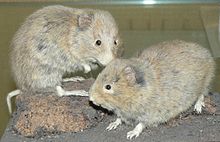Orkney vole
| Orkney vole | |
|---|---|

| |
| Orkney vole (Microtus arvalis orcadensis) in the Natural History Museum at Tring | |
| Scientific classification | |
| Domain: | Eukaryota |
| Kingdom: | Animalia |
| Phylum: | Chordata |
| Class: | Mammalia |
| Order: | Rodentia |
| Family: | Cricetidae |
| Subfamily: | Arvicolinae |
| Genus: | Microtus |
| Species: | |
| Subspecies: | M. a. orcadensis
|
| Trinomial name | |
| Microtus arvalis orcadensis Millais, 1904
| |
| Synonyms | |
|
Microtus orcadensis | |
The Orkney vole (Microtus arvalis orcadensis) is a population of the common vole (Microtus arvalis) found in the Orkney Islands, off the northern coast of Scotland, as well as in the Channel Island of Guernsey.[3] Orkney voles are about 10% larger than voles from other populations of the common vole.[3] The common vole is absent from the rest of the British Isles.
Distribution and habitat[edit]
The Orkney vole occurs on eight islands of the group, Mainland, Sanday, Westray, Rousay, South Ronaldsay, Burray, Eday and Stronsay.[4]
Taxonomy[edit]
In the past the populations on each of these islands have been named as subspecies, and the Orkney vole as a whole is considered by some taxonomists to be a subspecies of the common vole because of its size difference from the common vole. However, others do not recognise any subspecies of the common vole,[2] especially since DNA analysis indicates transport by Neolithic humans from what is now Belgium.[5] Chromosome studies have shown however, that despite being twice as heavy as continental voles, they are conspecific and should be regarded as a subspecies.[4]
Origin[edit]
Microtus arvalis does not occur in mainland Britain, nor elsewhere in the British Isles. It was hypothesised that the Orkney voles were a relict population, left behind when the land-bridge connecting Scotland and Orkney had disappeared, by the date that the more competitive Microtus agrestis had reached Northern Scotland. This theory has now been rejected on palaeontological, ecological, biological and geological grounds.
It is now accepted that they were introduced to the Orkney archipelago by humans in Neolithic times, possibly concealed in animal fodder. The oldest known radiocarbon-dated fossil of the species in Orkney is 4,600 years old: this marks the latest possible date of introduction.[4]
References[edit]
- ^ Marshall, Claire (13 June 2018). "One in five British mammals faces extinction". BBC News.
- ^ a b Wilson, D. E.; Reeder, D. M., eds. (2005). Mammal Species of the World: A Taxonomic and Geographic Reference (3rd ed.). Johns Hopkins University Press. ISBN 978-0-8018-8221-0. OCLC 62265494.
- ^ a b "'Giant' vole found during island study". BBC News. 22 October 2018.
- ^ a b c Thaw, Susan; Jaarola, Maarit; Searle, Jeremy B.; Dobney, Keith M. (2001). "Lost in Space: the origin of the Orkney vole Microtus arvalis orcadensis and its potential for reconstructing human dispersal and trade and exchange networks in the Neolithic". Orkney Archaeological Trust. Retrieved 1 March 2020.
- ^ Martínková, Natália; Barnett, Ross; Cucchi, Thomas; Struchen, Rahel; Pascal, Marine; Pascal, Michel; Fischer, Martin C.; Higham, Thomas; Brace, Selina (1 October 2013). "Divergent evolutionary processes associated with colonization of offshore islands". Molecular Ecology. 22 (20): 5205–5220. doi:10.1111/mec.12462. ISSN 1365-294X. PMC 4159590. PMID 23998800.

